
26 minute read
SAFE OPERATION
from K. Tractor Manual
PRECAUTIONS OF THE TRACTOR
Careful operation is your best insurance against an accident. Read and understand this manual carefully before operating the tractor. All operators, no matter how much they have experience, should read this and other related manuals before operating the tractor or any implement attached to it. It is the owner's obligation to instruct all operators in safe operation.
Advertisement
1. Precautions before operating the tractor
Know your equipment and its limitations. Read this entire manual before starting and operating the tractor.
1.1 General precautions
•Pay special attention to the safety labels on the tractor. •Do not operate the tractor or any implement attached to the tractor while under the influence of alcohol, medication, controlled substances, or while you are fatigued. •Carefully check the vicinity of the tractor before operating it or any implement attached to it. Do not allow any bystander around or near the tractor during operating it. •Before allowing other people to use your tractor, explain them how to operate it and have them read this manual before operating it. •Never wear loose, torn, or bulky clothing around the tractor. Loose, torn, or bulky clothing may catch on moving parts or controls, leading to the risk of an accident. Use additional safety items: hard hat, safety boots or shoes, eye and hearing protection, gloves, and so on, as appropriate or required. •Do not allow passengers to ride on any part of the tractor at anytime. The operator must remain in the operator's seat during operating the tractor. •Check the brakes, clutch, linkage pins, and other mechanical parts for improper adjustment and wear. Replace worn or damaged parts promptly.
Check the tightness of all nuts and bolts regularly.
For further details, see 4. Checking the wheel bolt torque on page 124. •Keep your tractor clean. Buildups of dirt, grease, and trash may contribute to fires and lead to personal injury. •Use only implements meeting the specifications listed under IMPLEMENT LIMITATION TABLES on page 40, or implements approved by KUBOTA. •Use proper weights on the front or rear of the tractor to reduce the risk of upsets. When using the front loader, put an implement or ballast on the 3point hitch to improve stability. Follow the safe operating procedures specified in the implement or attachment manual. •Do not modify the tractor. Unauthorized modification may affect the function of the tractor, which may result in personal injury.
1.2 Precautions for CAB and ROPS
KUBOTA recommends the use of a CAB or roll-overprotective-structures (ROPS), and seat belt in almost all applications. Combination of a CAB or ROPS and seat belt will reduce the risk of serious injury or death if the tractor should be upset. •Check for overhead clearance which may interfere with a CAB or ROPS. •Set the parking brake and stop the engine. Remove any obstructions which may prevent raising or folding the ROPS. Do not allow any bystander.
Always perform functions of CAB or ROPS from a stable position at the rear of the tractor. Hold the top of the ROPS securely when raising or folding it.
Make sure that all pins are installed and locked. •If the CAB or ROPS is loosened or removed for any reason, make sure that all parts are reinstalled correctly before operating the tractor. •Never modify or repair any structural member of a
CAB or ROPS because welding, bending, drilling, grinding, or cutting it may weaken the structure. •If any structural member of the CAB or ROPS is damaged, replace the entire structure at your local
KUBOTA Dealer. •If the tractor is equipped with a foldable ROPS, you may fold down it temporarily only when absolutely necessary to fold down it for areas with constraints on height.
There is no protection of operator provided by the
ROPS in the folded position. For operator safety, you should place the ROPS in the upright and locked position and fasten the seat belt for all other operations. •Always use the seat belt if the tractor is equipped with a CAB or ROPS.
Do not use the seat belt if a foldable ROPS is down or there is no ROPS. Check the seat belt regularly and replace if frayed or damaged.
(1) ROPS
(2) Seat belt
2. Precautions for operating the tractor
Operator safety is a priority. Safe operation, specifically with respect to overturning hazards, entails understanding the equipment and environmental conditions at the time of use. Some prohibited uses which can affect overturning hazards include traveling and turning with implements and loads carried too high, and so on. This manual sets forth some of the obvious risks, but the list of risks is not exhaustive, and the list of risks cannot be exhaustive. It is the operator's responsibility to be alert for any equipment or environmental condition that could compromise safe operation.
•Always sit in the operator's seat when starting the engine or operating the levers or controls. Adjust the operator's seat referring to 1. Operator's seat on page 48. Never start the engine while you are standing on the ground. •Before starting the engine, make sure that all levers including auxiliary control levers are in their neutral positions, that the parking brake is engaged, and that the power take-off (PTO) is disengaged or off.
Fasten the seat belt if the tractor is equipped with a
CAB, a fixed ROPS, or a foldable ROPS in the upright and locked position. •Do not start the engine by shorting across starter terminals or bypassing the safety start switch. The tractor may start in gear and move if normal starting circuitry is bypassed. •Do not operate or idle the engine in a nonventilated area. Carbon monoxide gas is colorless, odorless, and deadly. •Check that the operator-presence-control-system (OPC) are functioning correctly before each time you use the tractor. Test safety systems. See 2. Checking the engine start system on page 123 and 3. Checking the OPC (operator presence control) system on page 124. Do not operate unless they are functioning correctly.
2.2 Precautions for working the tractor
•Pull only from the hitch. Never hitch to the axle housing or any other point except the hitch.
Hitching to the axle housing or any other point except the hitch will increase the risk of serious personal injury or death due to a tractor upset.
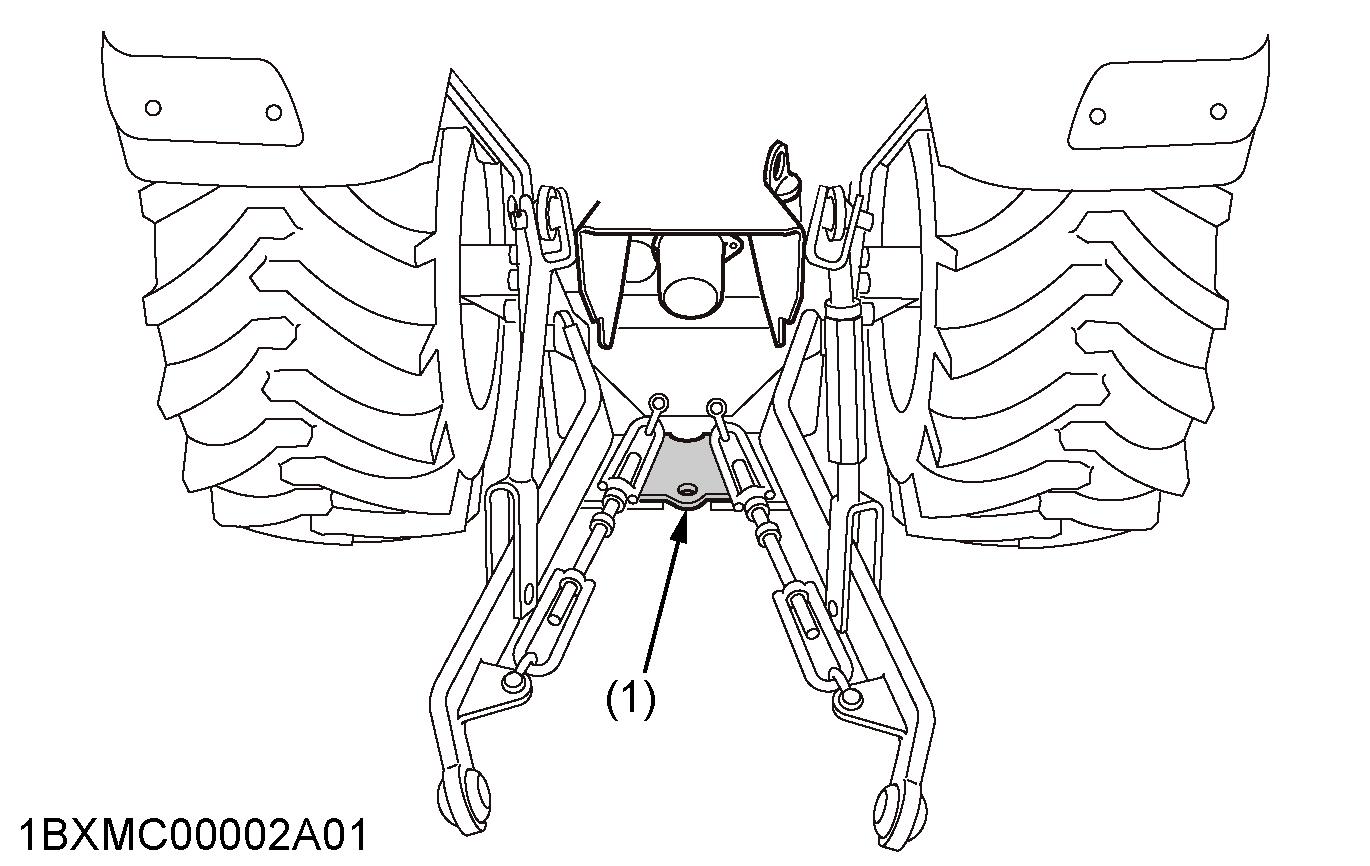
(1) Hitch •Keep all shields and guards in place. Replace any shield or guard that are missing or damaged. •Avoid sudden starts. To avoid upsets, slow down when turning, on uneven ground, and before stopping. •The tractor cannot turn with the differential locked.
Do not turn with the differential locked as it could be dangerous. •Do not operate the tractor near ditches, holes, embankments, or other ground surface features which may collapse under the weight of the tractor.
The risk of tractor upset is even higher when the ground is loose or wet. Tall grass can hide obstacles, so walk the area first to be sure. •Watch where you are going at all times. Watch for and avoid obstacles. Be alert at row ends, near trees, and other obstructions. •When working in groups, always let the others know what you are going to perform before you perform it. •Never try to get on or off a moving tractor. •Always sit in the operator's seat when you are operating levers or controls. •Do not stand between the tractor and the implement or trailed vehicle unless parking brake is applied. •Do not operate or tow the tractor at speeds exceeding specific travel speed.
2.3 Safety for children
Tragedy can occur if the operator is not alert to the presence of children. Children generally are attracted to machines and their work. •Never assume that children will remain where you last saw them. •Keep children out of the work area and under the watchful eye of another responsible adult. •Be alert and shut the tractor down if children enter the work area. •Never carry children on the tractor. There is no safe place for them to ride. They may fall off and be run over or interfere with your control of the tractor. •Never allow children to operate the tractor even under adult supervision. •Never allow children to play on the tractor or on the implement. •Use extra caution when the tractor is backing up.
Before the tractor starts to move, look down and behind to make sure that the working area is clear.
Slopes are a major factor related to loss-of-control and tip-over accidents, which can result in severe injury or death. All slopes require extra caution. •To avoid upsets of the tractor, always back it up steep slopes. If you cannot back the tractor up on the slope or if you feel uneasy to back it up on the slope, do not operate the tractor on the slope. Stay off the slopes which is too steep for safe operation. •Driving forward out of a ditch, mired condition, or up a steep slope increases the risk of the tractor to be upset backward. Always back the tractor out of a ditch, mired condition, or steep slope. The 4-wheel drive models require extra caution because their increased traction can give the operator false confidence in the ability of the tractor to climb the slopes. •Keep all movement of the tractor on slopes slow and gradual. Do not change the speed or direction of the tractor suddenly. Do not apply brake suddenly. Do not move the steering wheel suddenly. •Avoid changing the gears speed when the tractor is climbing or going down a slope. Changing the gears to neutral on a slope could cause loss of control. •You should pay special attention to the weight and location of implements and loads because they will affect the stability of the tractor. •To improve stability of the tractor on slope, follow recommendations for proper ballasting as shown in
BALLAST on page 91 •When driving down a slope, make sure that 4-wheel drive is engaged to increase traction if equipped.
•Check the front wheel engagement. The braking characteristics are different between 2-wheel drive and 4-wheel drive. Know the difference and use carefully. •Always slow the tractor down before turning.
Turning at high speed may tip the tractor over. •Make sure that the slow-moving-vehicle (SMV) sign is clean and visible. Use the hazard lights and turn signals as required. •On public roads, use the SMV emblem and hazard lights, if required by local traffic and safety regulations.
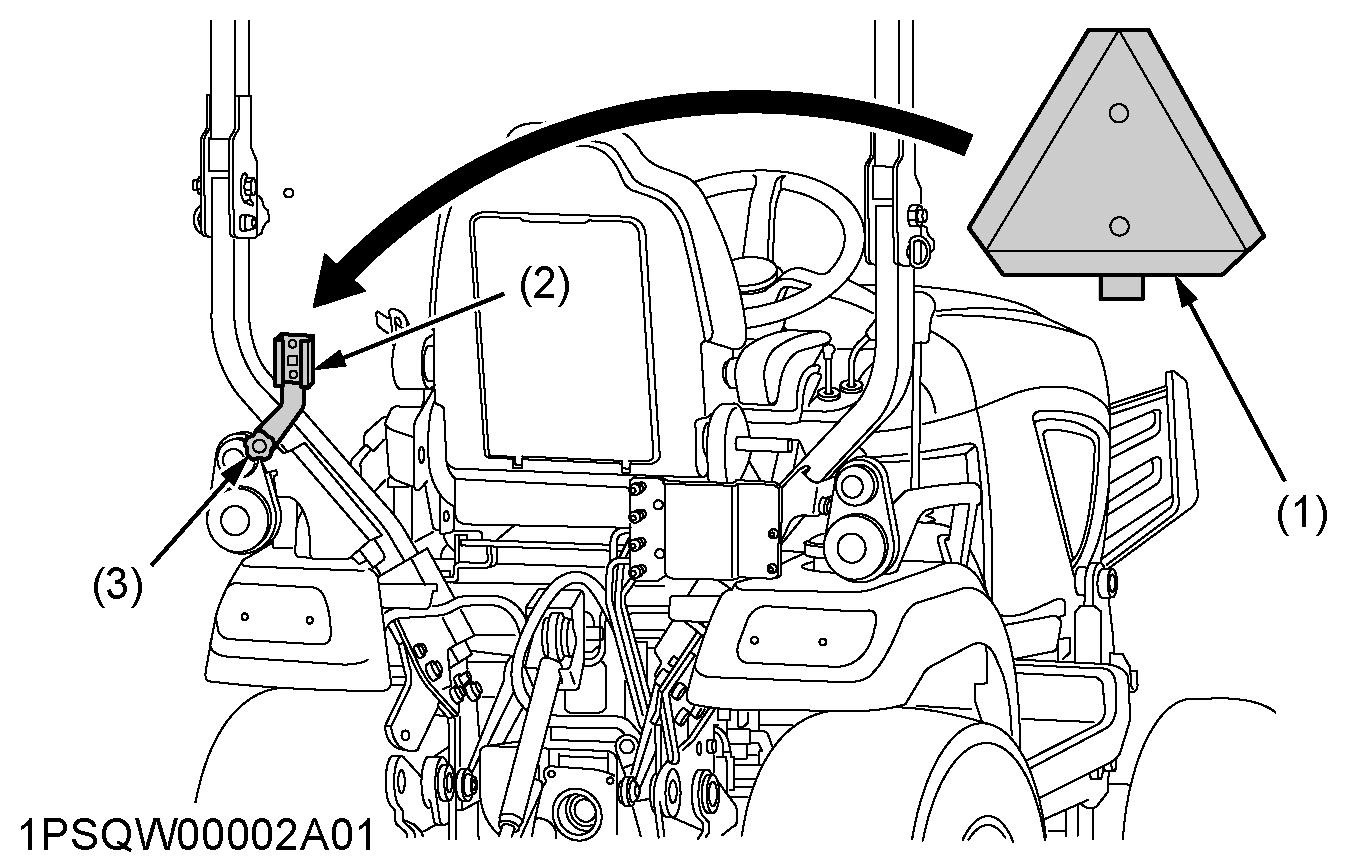
(1) SMV emblem (2) Bracket (3) Knob nut
•Check all local traffic and safety regulations. •Turn the headlights on. Dim the headlights when meeting another vehicle. •Drive at speeds that allow you to maintain the control at all times. •Do not apply the differential lock while traveling at road speeds. The tractor may run out of control. •Avoid sudden motions of the steering wheel because they can lead to a dangerous loss of stability. The risk is especially great when the tractor is traveling at road speeds. •Keep the ROPS in the up position and wear the seat belt when driving the tractor on the road.
Otherwise, you will not be protected in the event of a tractor roll-over. •Do not operate an implement while the tractor is on the road. Lock the 3-point hitch in the raised position. •When towing other equipment, use a safety chain and place an SMV emblem on the equipment as well.
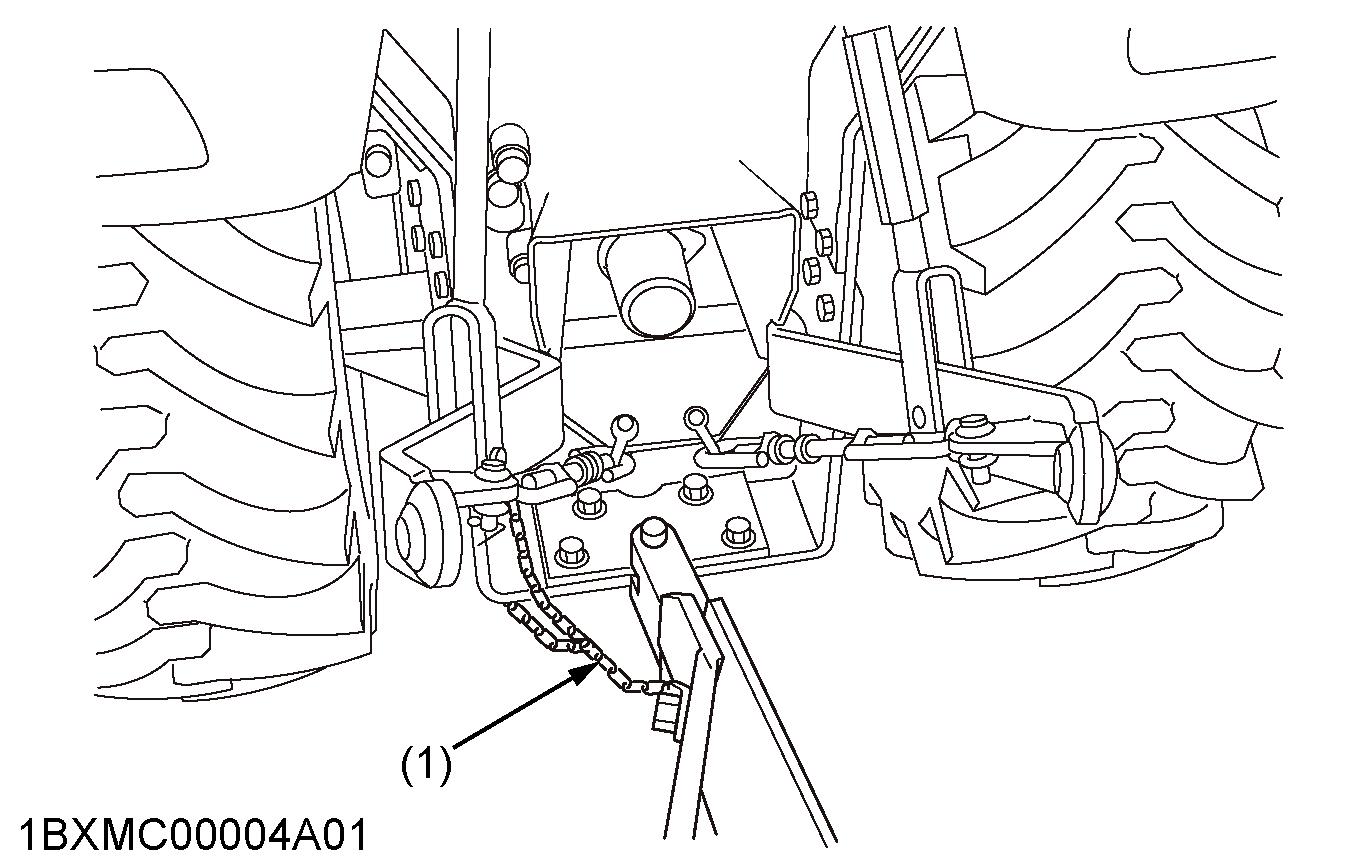
(1) Safety chain •Set the implement-lowering-speed-knob in the lock position to hold the implement in the raised position.

(1) 3-point hitch lowering speed knob (A) Fast (B) Slow (C) Lock
3. Precautions for parking the tractor
•Disengage the PTO, lower all implements to the ground, place all control levers in their neutral positions, set the parking brake, stop the engine, remove the key from the ignition, and lock the cab door if equipped. Leaving the transmission in gear with the engine stopped will not prevent the tractor from rolling.

(1) Brake pedal (2) Parking brake pedal (A) Depress
(B) Push down parking brake pedal while depressing brake pedal •Make sure that the tractor has come to a complete stop before dismounting from the tractor. •Avoid parking on steep slopes. If it is at all possible, park on a firm and level surface. If it is not at all possible to park on a firm and level surface, park across a slope and chock the wheels.
Failure to comply with the preceding warning may allow the tractor to move and could cause injury or death.
4. Precautions for operating the PTO
•Wait until all moving components have completely stopped before getting off the tractor, connecting, disconnecting, adjusting, cleaning, or servicing any
PTO driven equipment. •Keep the PTO-shaft-cover in place at all times.
Replace the PTO-shaft-cap when the shaft is not in use.
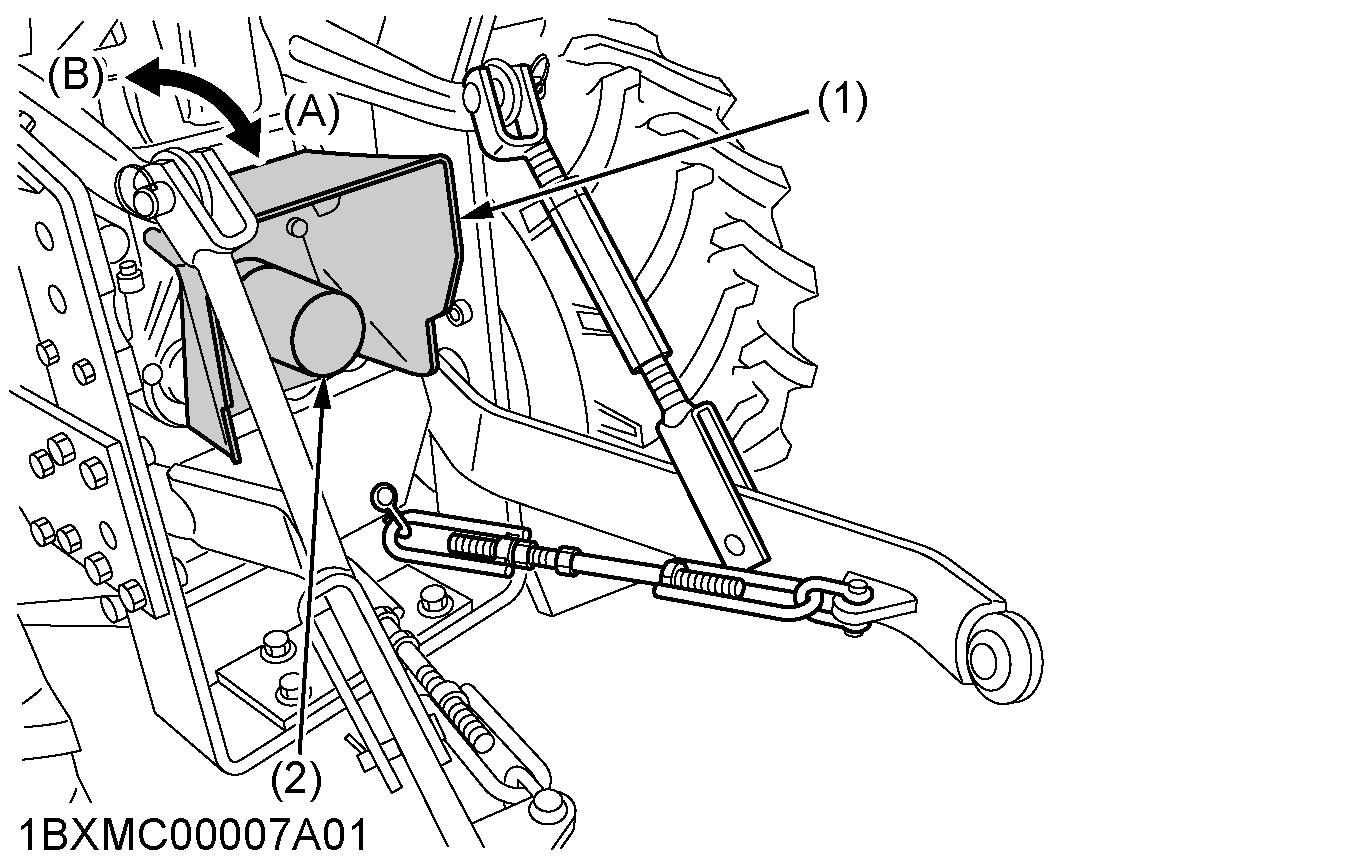
(1) PTO shaft cover (2) PTO shaft cap (A) Normal position (B) Raised position
•Before installing or using the PTO-drivenequipment, read the manufacturer's manual and review the safety labels attached to the equipment. •When operating the stationary PTO-drivenequipment, always apply the parking brake of tractor and place the chocks behind and in front of
the rear wheels. Stay clear of all rotating parts. Never step over rotating parts.
5. Precautions for using 3-point hitch
•Use the 3-point hitch only with equipment designed for 3-point hitch usage. •When using an implement mounted to the 3-point hitch, be sure to install the proper counterbalanceweight on the front of the tractor. •When transporting the loads on the road, set the implement-lowering-speed-knob in the lock position to hold the implement in the raised position.

(1) 3-point hitch lowering speed knob (A) Fast (B) Slow (C) Lock
•To avoid injury from separation, do not extend the lift rod beyond the groove on the threaded rod.

(1) Groove
6. Precautions for servicing the tractor
Before servicing the tractor, follow the following procedure. 1.park the tractor on a firm, flat, and level surface. 2.Set the parking brake. 3.Lower all implements to the ground. 4.Place the gear-shift-lever in the neutral position. 5.Stop the engine. 6.Remove the starter key. •Allow the tractor time to cool off before working on or near the engine, muffler, radiator, and so on. •Do not remove the radiator cap while coolant is hot.
When coolant is cool, slowly rotate the radiator cap to the first stop and allow sufficient time for excess pressure to escape before removing the radiator cap completely. If the tractor equips a coolantrecovery-tank, add coolant or water to the coolantrecovery-tank. Do not add coolant to the radiator.
See 5. Checking the coolant level on page 121. •Always stop the engine before refueling. Avoid spills and overfilling. •Do not smoke when working around the battery or when the tractor is refueling. Keep all sparks and flames away from the battery and fuel tank. The battery presents an explosive hazard, because it gives off hydrogen and oxygen especially when you are recharging it. •Before jump starting a dead battery, read and follow all of the instructions. See JUMP STARTING THE
ENGINE on page 60. •Keep first-aid-kit and fire extinguisher handy at all times. •Disconnect the ground cable of battery before working on or near electric components. •To avoid the possibility of battery explosion, do not use or charge the refillable type battery if the fluid level is below the lower (lower limit level) mark.
Check the fluid level regularly and add distilled water as required so that the fluid level is between the upper and lower levels. •To avoid sparks from an accidental short circuit, always disconnect the ground cable (-) of battery first and reconnect it last.

(1) Battery •Do not mount a tire on a rim. A qualified person should mount a tire on a rim with the proper equipment. •Always maintain the correct tire pressure. Do not inflate the tires above the recommended pressure shown in 1. Inflation pressure of tires on page 89.

•Securely support the tractor when either changing wheels or adjusting the width of wheel tread. •Make sure that the wheel bolts have been tightened to the specified torque. See WHEEL TREAD on page 89. •Do not work under any hydraulically supported devices. They can settle, suddenly leak down, or be accidentally lowered. If it is necessary to work under the tractor or any machine elements for servicing or adjustment, securely support them with stands or suitable blocking beforehand. •Escaping hydraulic fluid under pressure obtains sufficient force to penetrate skin, so escaping hydraulic fluid under pressure can cause serious personal injury. Before disconnecting the hydraulic lines, be sure to release all residual pressure.
Before applying pressure to the hydraulic system, make sure that all connections are tight and that all lines, pipes, and hoses are free of damage.
•Hydraulic fluid escaping from pinholes may be invisible. Do not use hands to search for suspected leaks. Use a piece of cardboard or wood to search for suspected leaks. You should use safety goggles or other eye protection. If injured by escaping fluid, see a medical doctor at once. Hydraulic fluid will produce gangrene or severe allergic reaction.


(1) Cardboard (2) Hydraulic line (3) Magnifying glass
•Waste products such as used oil, fuel, hydraulic fluid, and batteries, can harm the environment, people, pets, and wildlife. Please dispose properly.
See your local recycling center or KUBOTA Dealer to learn how to recycle or get rid of waste products.
PRECAUTIONS OF THE LOADER
You can avoid most accidents of the loader equipment by simple safety precautions. Safety precautions of the loader, if you follow at all times, will help you operate your loader safely.
1. Precautions before operating the loader
•Read and understand all instructions and precautions in both the tractor and the loader operator's manuals before using the loader.
Lack of knowledge can lead to accidents. •It is the owner's responsibility to make sure that anyone who will operate the loader reads this manual first and becomes familiar with the safe operation of the loader. •For your safety, KUBOTA strongly recommend using a ROPS (roll-overprotective-structures) with a seat belt in almost all applications. If your tractor equips a foldable ROPS, fold it down only when absolutely necessary and raise it up and lock it again as soon as possible. Do not wear the seat belt when a foldable ROPS is down or a fixed
ROPS is removed. If you get any questions, consult your local KUBOTA dealer.
Always use the seat belt when the tractor is equipped with a ROPS. Never use the seat belt when the tractor is not equipped with a ROPS. •Visually check for hydraulic leaks and broken, missing, or malfunctioning parts.
Perform necessary repairs before operating the loader.
•Replace damaged or illegible safety labels. See 2. Safety labels of the loader on page 20 for required labels. •When the front loader is mounted on the tractor, enter and exit the operator's seat only from left side of the tractor. •Engage the loader-control-valve-lock to prevent accidental actuation when the implement is not in use or during transport. Do not utilize the loadercontrol-valve-lock for maintenance or repair of the machine. •Assemble, remove, and reinstall the loader only as directed in this manual. Otherwise, serious personal injury or death may result. •Follow the following precautions when attaching the implements. –Make sure that both handles of the boom LH and RH contact the ear plates at the points (A) and are all the way down. –Make sure that both lock pins of the boom LH and RH protrude through the pin slots. –KUBOTA recommends the use of KUBOTA attachments on KUBOTA loaders. NonKUBOTA attachments, if used, must comply with ISO 24410, first edition 2005-04-15. –Use of a non-KUBOTA attachment that does not comply with ISO 24410 or the improper positioning of handle(s) or non-protrusion of pin(s) may result in detachment of the attachment or deformation, causing loss of performance, personal injury, or death.
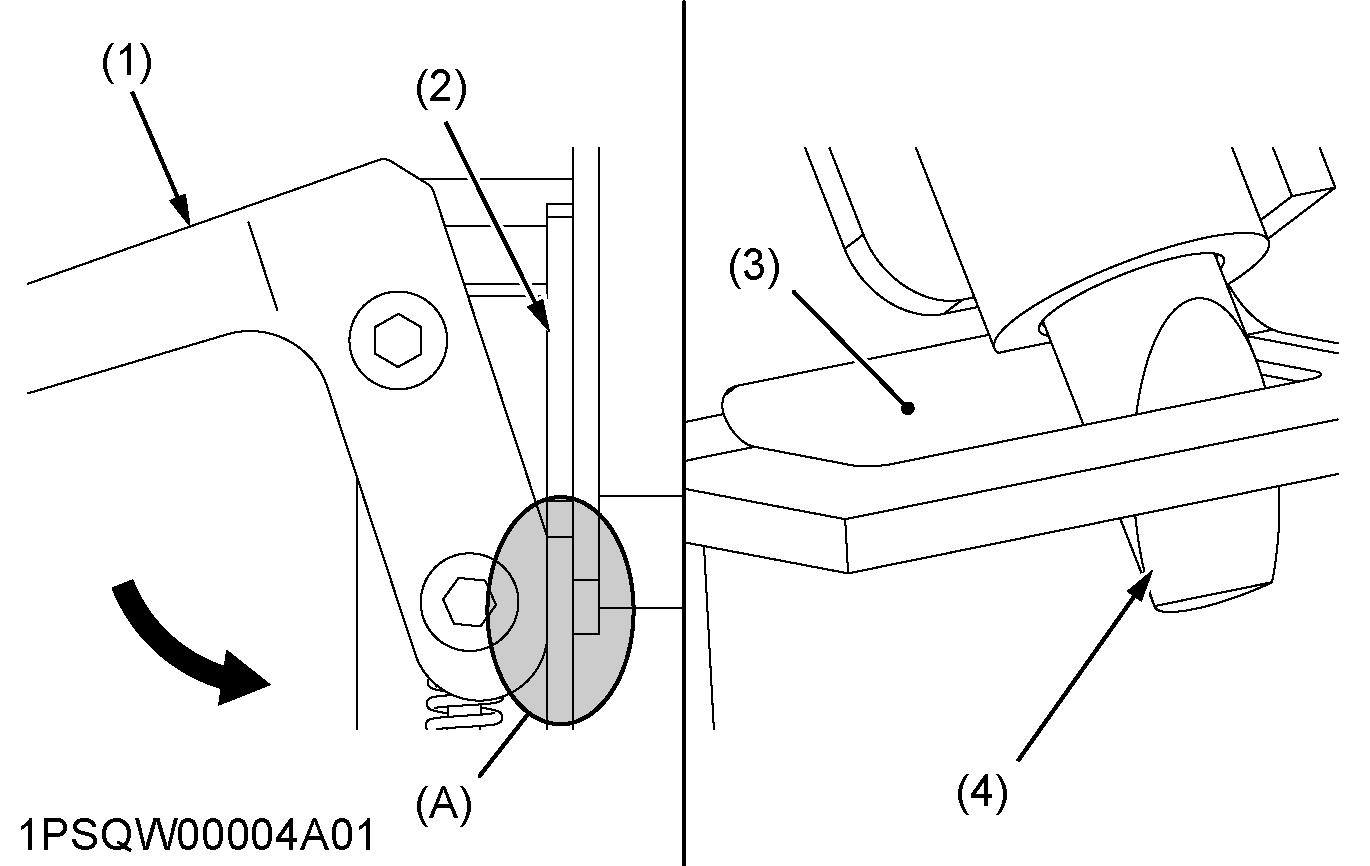
(1) Handle (2) Ear plate (3) Pin slot (4) Lock pin (A) Points where the handle contacts the ear plate.
2. Precautions for operating the loader
•Operate the loader only when properly seated at the controls. Do not operate the loader from the ground. •Move and turn the tractor at low speeds. •Never allow anyone to get under the bucket of the loader or reach through the boom when the bucket is raised. •Keep children, others, and livestock away when operating the loader and the tractor. •Do not walk or work under a raised bucket of the loader or attachment unless it is securely blocked and held in position. •For the stability of the tractor and operator's safety, add rear ballast to the 3-point hitch and to the rear wheels when using the loader. •To increase stability of the application, adjust the rear wheels to the widest setting that is suitable for your application. •Exercise extra caution when operating the loader with a raised bucket or attachment. •Do not lift or carry any person on the loader, in the bucket, or other attachment. •Avoid loose fill, rocks, and holes. Loose fill, rocks, and holes can be dangerous for operation or movement of the loader. •Avoid overhead wires and obstacles when the loader is raised. Contacting the electric lines can cause electrocution. •Gradually stop the loader boom when lowering or lifting. •Use caution when handling loose or shiftable loads. •When using the loaders for handling large, heavy, or shiftable objects, using proper handling attachments with them is recommended. •Handling large, heavy objects can be extremely dangerous due to the following reasons: –Danger of rolling the tractor over –Danger of upending the tractor –Danger of the object rolling or sliding down the boom of the loader onto the operator •If you must handle the large, heavy objects, protect yourself by the following preventive measures: –Never lift the load higher than necessary to clear the ground. –Add the rear ballast to the tractor to compensate for the load, or use the rear implement. –Never lift large objects with the equipment that may permit the large objects to roll back onto the operator. –Move slowly and carefully, avoiding rough terrain. •Never lift or pull a load from any point on the loader or any attachments with a chain, rope, or cable.
Otherwise, rollover or serious damage to the loader may occur. •Be extra careful when operating the tractor on a slope. Always operate the tractor up and down, and never across the slope.
Do not operate the tractor on steep slopes or unstable surfaces.
•When operating another implement on a hillside, be sure to remove the loader to reduce the risk of rollover. •Carry the boom of the loader at a low position during transport. Be able to see over the bucket. •Allow for the length of the loader when turning it.
3. Precautions after operating the loader
•When loader work is complete and parking or storing, follow the following procedures before leaving the operator's seat of the tractor. 1.Choose flat, hard ground. 2.Lower the boom of the loader to the ground. 3.Stop the engine. 4.Set the brakes. 5.Remove the starter key. •Make sure that the detached loader is on stands and on a hard, level surface. •Before disconnecting the hydraulic lines, relieve all hydraulic pressure by moving the controls. •Do not remove the loader from the tractor without an approved bucket attached.
4. Precautions for servicing the loader
•Always wear the safety goggles when servicing or repairing the machine. •Do not modify the loader. Unauthorized modification may affect the function of the loader, which may result in personal injury. •Do not use the loader as a work platform or a jack to support the tractor for servicing or maintenance.
Securely support the tractor or any machine elements with stands or suitable blocking before working underneath.
For your safety, do not work under any hydraulically supported devices. Hydraulically supported devices can settle, suddenly leak down, or be accidentally lowered. •Escaping the hydraulic oil under pressure can obtain sufficient force to penetrate the skin, causing serious personal injury. Do not use hands to search for suspected leaks. If injured by escaping fluid, obtain medical treatment immediately. •Do not tamper with the setting of the relief valve.
The relief valve is pre-set at the factory. Changing the setting of the relief valve can cause overloading of the loader and tractor which may result in serious personal injury. •When servicing or replacing the pins in cylinder ends, bucket, and so on, always use a brass drift and hammer. Otherwise injury from flying metal fragments could result.
PRECAUTIONS OF THE BACKHOE
Most accidents of the backhoe equipment can be avoided by simple safety precautions. Safety precautions of the backhoe, if you follow at all times, will help you operate your backhoe safely.
1. Precautions before operating the backhoe
•Read and understand all precautions in this manual before service or operation. Allow only trained personnel to operate or service the backhoe. •It is the owner’s responsibility to make sure that anyone who will operate the backhoe reads this manual first and becomes familiar with the safeoperation of the backhoe. •For safe operation of the backhoe, check the mounting-bolts for tightness and check that the mount levers are in the right position before operation the backhoe. •Never operate the tractor with the backhoe attached and the loader removed. •Check for buried material such as electrical lines, telephone lines, gas lines, and water lines. When in doubt about buried material, contact local utility companies for their buried location prior to operating the backhoe. •Replace any safety decal that becomes damaged, lost, or illegible. Also renew all decals when repainting.
2. Precautions for operating the backhoe
•Do not allow anyone other than the operator on the unit of the backhoe while in operation or transport. •Keep all person and animals away from swing area of backhoe. •Pay attention to the backhoe when operating it on slopes to avoid tipping-over of the machine. Travel at a speed compatible with safe operation, especially when operating the machine on uneven terrain, crossing ditches, or while turning. •Operate the backhoe from the backhoe operator's seat only. •When using the backhoe on slopes, one stabilizer may be lower than the other. Pay extreme attention to the backhoe during excavation because the risk of tipping-over of the machine will increase. •To reduce the risk of tipping-over of the machine on a slope, place the spoil to the high side of the excavation. •Do not dig under the stabilizer or the tractor, especially in soft or sandy condition. Take extra precaution in wet or thawing ground.
The machine can become unstable in wet or thawing conditions and these conditions may collapse under the weight of the machine and may cause tipping-over of the machine. •Never operate the machine or any equipment while under the influence of alcohol or other drugs, or while fatigued. •When leaving the machine unattended, be sure to lower the backhoe to the ground. Set the parking brake, then shut the engine off and remove the key.
3. Precautions of the backhoe while driving the tractor on the road
•Raise and center the boom, close the dipperstick, curl the bucket, and lock the boom before transporting the machine. •Check the local codes or regulations that may apply to tractor, loader, and backhoe operation on public streets or highways, before transporting or traveling of the machine. Use the slow-moving-vehicle (SMV) emblem and warning flashers as required.
4. Precautions for servicing the backhoe
•Before disconnecting the hydraulic lines, relieve all hydraulic pressure by moving the controls. •Always use personal protection device such as safety goggles and ear protection when servicing or repairing the machine. •Lower the backhoe to the ground and shut the engine off before servicing of the backhoe. •When servicing or repairing pins in cylinder ends, bucket, and so on, always use a brass drift and hammer. Failure to service or repair pins using a brass drift and hammer could result in injury from flying metal fragments. •To avoid serious personal injury, keep clear of working area of the backhoe. •When servicing or checking the backhoe underneath, do not get under the machine while it is being held with only the bucket, backhoe, or stabilizers. Securely support the machine with jack stands. •For your safety, do not work under any hydraulically supported machine elements. Hydraulically supported machine elements can settle, suddenly leak down, or be accidentally lowered. •Escaping hydraulic fluid under pressure can obtain sufficient force to penetrate the skin, which cause serious personal injury.
Before applying pressure to the hydraulic system, be sure that all connections are tight and that all lines, the pipes and the hoses are not damaged.
Hydraulic fluid escaping from a very small hole can be almost invisible. Do not use hands to search for suspected leaks. Use a piece of cardboard or wood.
If injured by escaping fluid, see a doctor at once.
Serious infection or allergic reaction will develop if proper medical treatment is not administered immediately. •Do not tamper with any setting of the pressure of the control valve and the relief valve of the backhoe. The pressure of the relief valve is preset at the factory. Changing the setting of the pressure of the relief valve can cause overloading of the backhoe and the tractor, and serious personal injury or death may result. •Do not modify the backhoe for any reason.
Modifying the backhoe can cause an unstable condition of combination of the tractor, the loader, and the backhoe, and serious personal injury or death may result.
SAFETY LABELS
1. Safety labels of the tractor
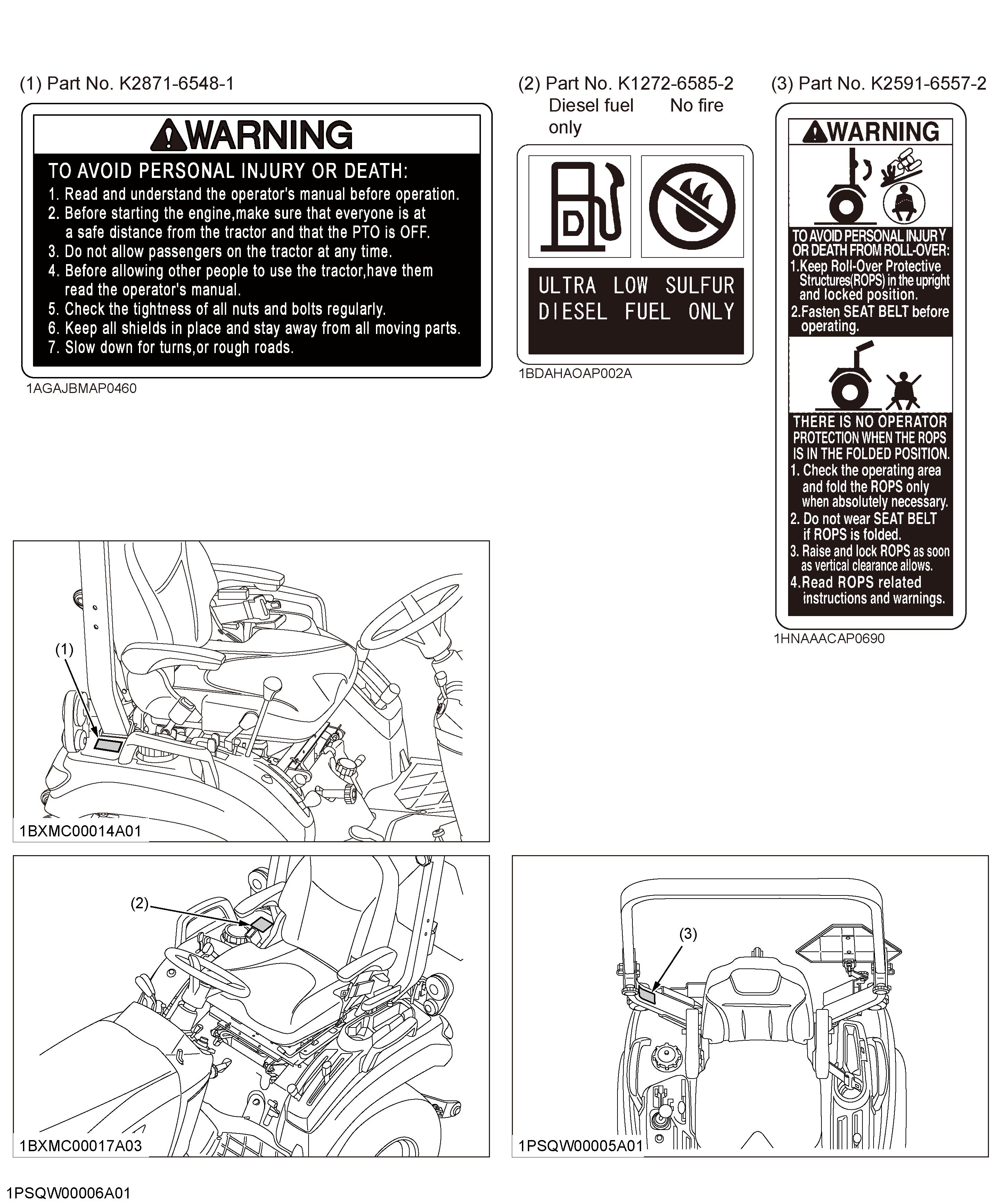


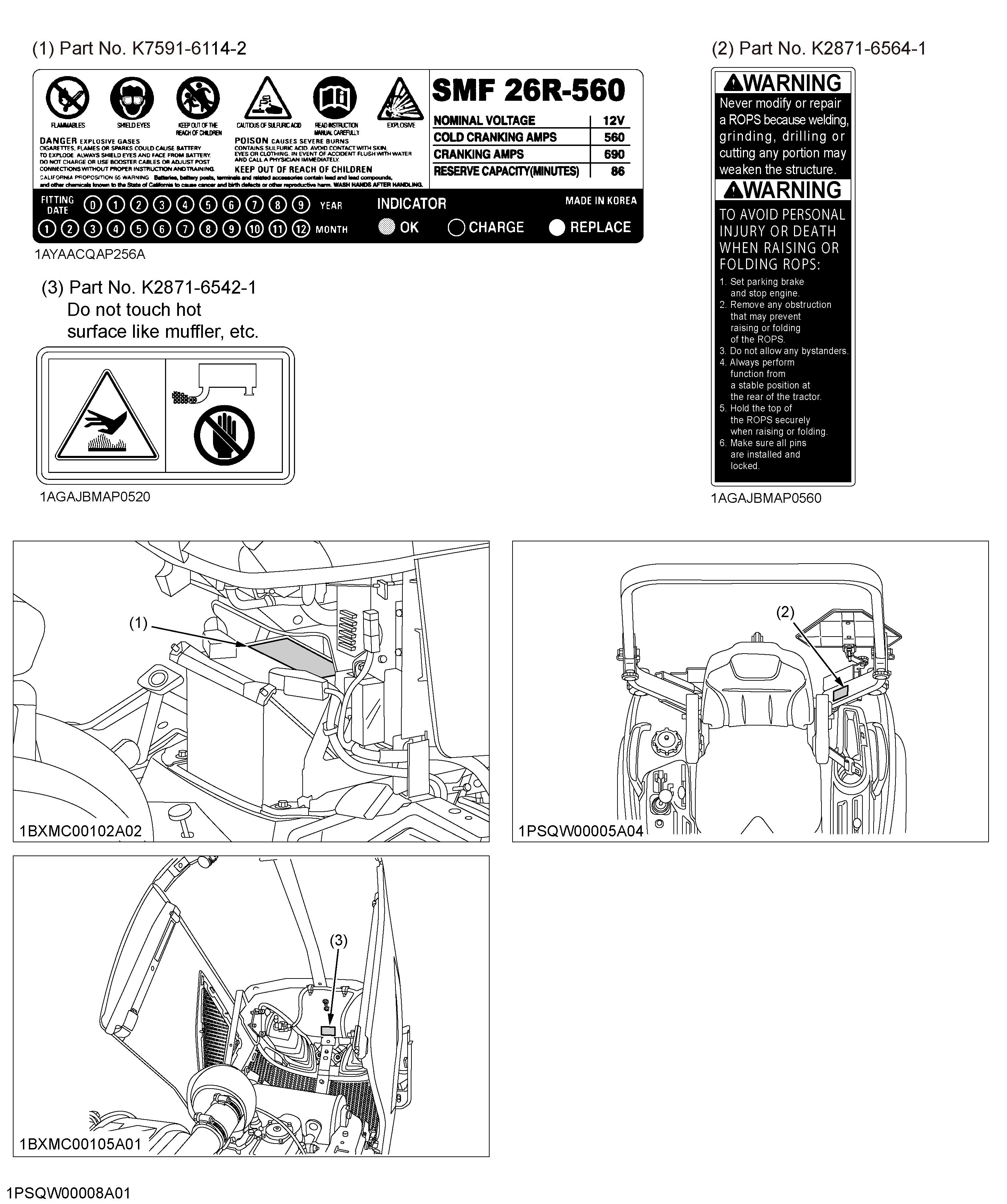
2. Safety labels of the loader
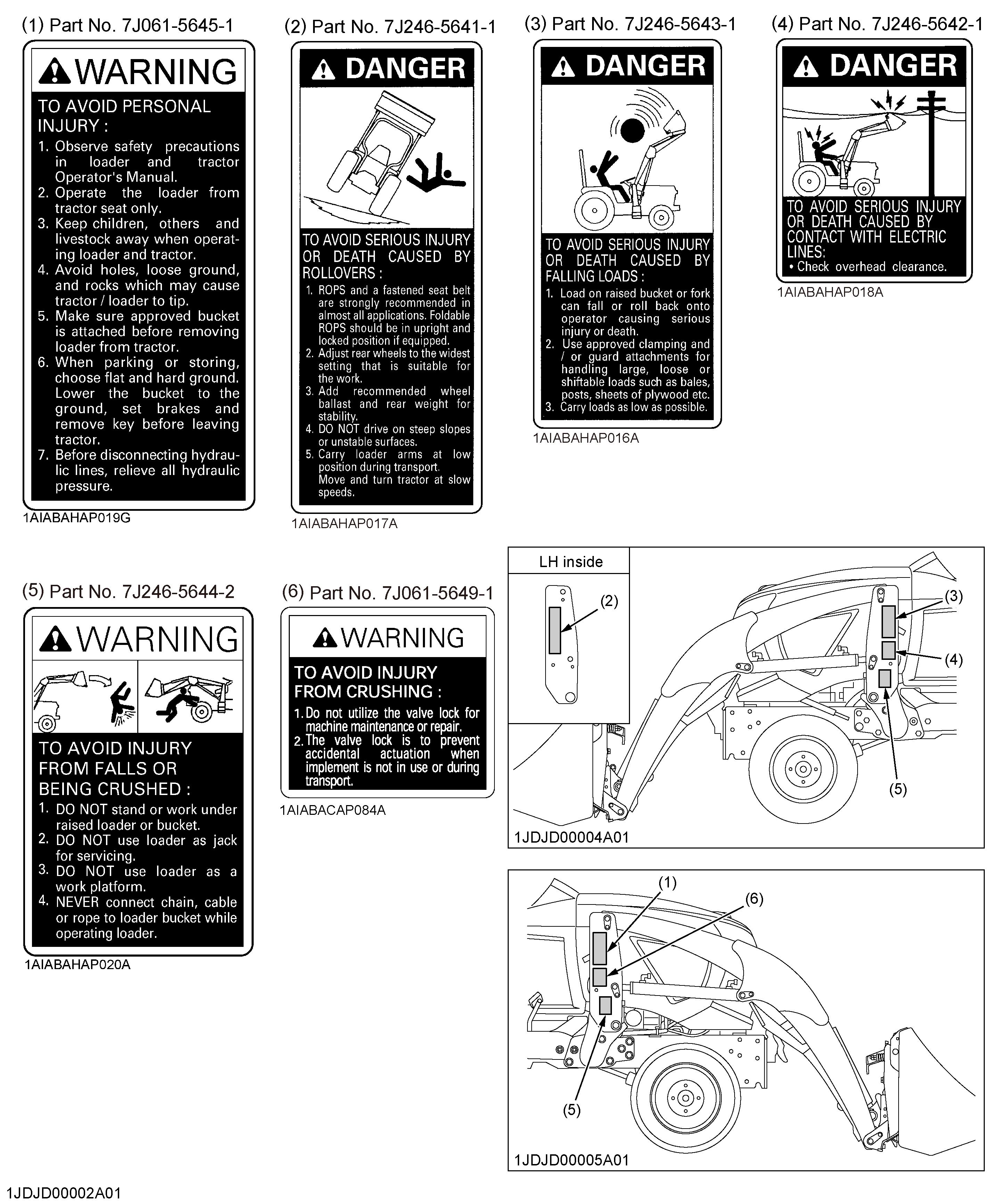

3. Safety labels of the backhoe


4. Care for safety labels
•Keep the safety labels clean and free from obstructing material. •Clean the safety labels with soap and water, and dry the safety labels with a soft cloth. •Replace damaged or missing safety labels with new safety labels from your local KUBOTA Dealer. •If a component with safety label(s) attached is replaced with new component, make sure that new safety label(s) is (are) attached in the same location(s) as the replaced component. •Attach new safety labels by applying on a clean, dry surface and pressing any bubbles to outside edge.

